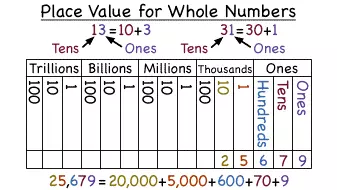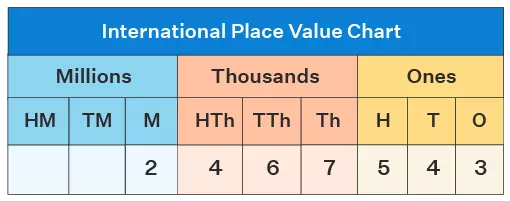In mathematics, “place-value” refers to the value assigned to each digit in a number based on where that digit appears. These locations begin from the area of the units (one place). The order of the place value of the digits in a number is stated as ones or units, tens, hundreds, thousands, ten thousand, and so on, moving from right to left in the number.
The value of each number is referred to as its place value. The site of a digit in a number affects the value assigned to that digit. A number can have two digits that are identical yet have distinct values. The location that each digit maintains inside the number is what determines the value of the digit.
The position or location of a digit inside a number is referred to as its place value. In a number, there is a specific spot allotted to each digit. The location of each digit will be enlarged when we express the number in its general form. These locations are measured from a “unit place,” also known as “one’s position,” as the starting point. From right to left, the sequence of the place assessment of the digits in a number is units, tens, hundreds, thousands, ten thousand, a hundred thousand, and so on.
Interpretation of Place Value

The value of a digit is determined by its location in the number, such as among the ones, the tens, the hundreds, and so on. This is known as place value. For instance, the place value of 5 in the number 3458 is five tens, equal to 50.
Nevertheless, the place value of five in the number 5781 is written as five thousand, also registered as 5,000. It is essential to grasp the concept that a digit may remain unchanged, but its significance may change depending on where it appears in the number.
Place Value for the Whole Numbers

The numbers 0 through 9 make up the foundation of the numerical system. These are considered to be in the position of the one whenever they are written by themselves. When two numbers are combined, the one that comes first, on the left, is in the tens position, and the one that comes second is in the part of the one. Therefore, seven would go in the tens place for the number seventy-two, and two would go in the position of the one.
Additional places include one hundred, one thousand, one hundred thousand, one million, and so on. In the number 20,306, the digit two would go in the ten thousand spots, the digit three would go in the hundreds spot, and the digit six would go in the one’s place.
Place Value for Decimals

When calculating the place value for whole numbers, the ones are located to the far right, and the place value increases to the left, so the tens are situated to the left of the ones. The hundreds are located to the far left of the ones. When working with decimals, place value is determined in the other direction, beginning with the tenths rather than the hundreds. The tenths, hundredths, thousandths, ten thousandths, and so on are all located to the right of the decimal point as you read.
In the number 0.938, for instance, the digit 9 appears in the tenth place, the digit 3 appears in the hundredths position, and the digit 8 appears in the thousandths position. In the number 4.2, the work of the one would be represented by a 4, and the tenth’s work would be represented by a 2.
The calculation of fractions is another area in which this may be useful. Because it is located in the tenth spot, the number 3 represents the fraction 3/10 when applied to the number 6.3. It is possible to write this number as either 6.3 or 6 3/10. The decimal value of 0.81 corresponds to the fraction 81/100 because eight is found in the tenth place, and one is in the hundredth position.
Importance of Using a Chart for Place Value

It might be challenging to learn how to calculate the place value of numbers, but with the help of a place value chart, this process can be simplified. The chart is declaiming from left to right, beginning with the possibility of the most excellent place value and progressing to the case of the least significant place value.
When dealing with whole numbers, it could travel from the position of millions to the work of ones, and when dealing with decimals, it might go to the place of thousandths. These are listed at the top of the charge, and the student is allowed to complete the chart with their own numbers to make it simpler to determine the appropriate place value of each number.
Now might be a decent time to give the place value chart a go and see if you can determine the place value for various integers, including whole numbers and decimals. When you need to complete more sophisticated math tasks like shifting the decimal over one or more place values, this will assist you in guaranteeing that you understand how to calculate the place value and how to write numbers.
According to the International Numerical System, which is used everywhere in the world, we count in the sequence of ones, tens, hundreds, thousands, tens of thousands, hundreds, and so on. Starting from the right, the numbers in this chart for place value are separated by a comma after every three digits.
The numbers are organized into periods of ones, thousands, millions, etc., and they are separated by these periods as well. Take the number 135,912,332, for instance; pay attention to where the commas are placed. Examine the International Place Value Chart that has been provided for your perusal down below. This chart displays the place value of numbers up to one hundred million.
Printable Place Value Charts

When working with place value systems, it is much simpler to commit information to memory and approach difficulties when utilizing a printable place value chart. The place values of numbers are presented in these charts in a tabular format across the empty spaces representing each digit. In addressing a problem by consulting these charts, we can immediately set the digits in their corresponding location according to the one in the number and assess their place values accordingly.
